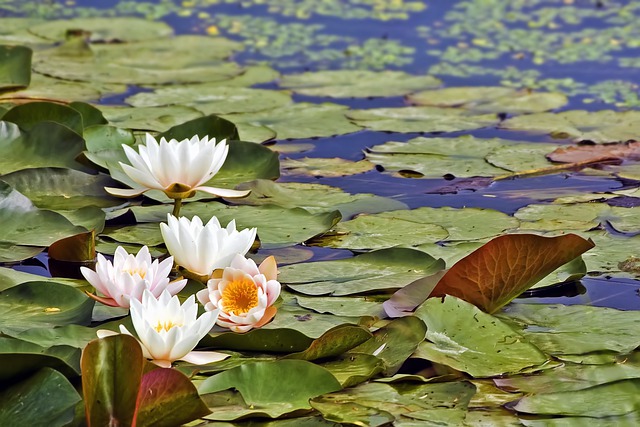 |  |  |    |  |
 |  |
The white water lily is a perennial water plant that grows up to 2m in height. The rhizome is thick, fleshy, dark brown in color, attached to the bottom of the water body with many small roots. Roots have many air channels that ensure gas exchange in the plant and keep the plant in a floating state. In addition, these air channels make the root much more durable, at the cellular level, so that it does not break under the influence of currents and wind. The leaves are large, round-oval with a depression at the base and pointed whole-edged lobes, located on cylindrical petioles. The color of the leaves changes depending on the age of the plant: in a young plant, the leaves are red, with time the top side becomes dark green, the bottom red-violet.
In July-August, green flower buds on long leaf stalks appear on the surface of the water. Water lily flowers are large (<15cm in diameter), aromatic, white, solitary. The flowers are bisexual (it has both male and female organs), flowering lasts 3-4 days. After pollination, the petals fall off and a barrel-shaped box containing many seeds is formed.
The blooming of the white water lily is a beautiful process, its petals open visibly, during the day the flower rotates, follows the sun. In the west, the flowers close and go completely under water. In rainy or windy weather, the flowers don't even rise to the surface of the water. From this sign, you can also conclude what kind of weather is expected, if the flowers have not appeared in the morning, you can expect bad weather, if the flowers appear, then the day will be sunny and calm.
Practically the entire plant is collected for medicinal purposes: rhizomes, flowers, leaves and seeds. The resources of the white water lily are limited, so they can be harvested only if the plant is really needed, and when harvesting, 70% of the plant must be left (we only take 3 out of 10 plants).
The rhizomes of the white water lily start to be collected at the beginning of flowering and the collection can be squatted until autumn. The rhizomes are collected using a special excavator to reach the plant at the bottom, then the plant is cleaned from the roots and leaf stems. The rhizomes are washed and cut into small pieces. The plant is dried in a well-ventilated and shady place, it is permissible to wrap the root, but the entire treatment process is carried out while protecting the plant from direct sunlight.
Flowers are collected in June-August, during flowering. Observing the peculiarities of the flowering of the plant, the plant begins to be harvested around 7 in the morning and no later than five in the evening, before the flower has gone under water. For medicinal purposes, flowers are used fresh, less often dried. A well-ventilated and shaded place can be used for drying.
White water lily leaves can be harvested at any time of the day, from early spring to the first frost. The leaves are dried in a well-ventilated and shaded place.
Seeds are collected from the surface of the water - they float in specific seed capsules or collect fruits that are under water. Seeds and fruits are dried in the same way as other plant parts.
White water lily rhizome contains <49% starch, 8% protein, it contains tannins (tannins), alkaloids nymphein, nymphalin and myricitrine glycosides, gallic acid and tartaric acid, <20% sugars, alkalis, bitter substances, ammonia, gums, essential oil. The petals contain the glycoside nymphalin, which is capable of strengthening the heart, flavonoids (kaempferol and quercetin glycosides). The seeds contain tannins, practically 10x less than the rhizomes, there are also essential oils and vegetable fats.
White water lily leaves contain oxalic acid, flavonoids, tannins.
Medicinal significance
White water lily has a pain-relieving and sleep-inducing effect on the human body. The alkaloid nymphene acts on the CNS and produces a psychoactive effect. The leaves contain the flavone glycoside myricitrin, which stimulates the heart. The tannins in the plant are effective against staphylococcus and salmonella, have an anti-inflammatory and softening effect on the digestive tract. The flavonoids in the petals increase the strength of blood capillaries, regulate arterial blood pressure and heart muscle activity. The alkali present in the plant has a laxative and antibacterial effect.
White water lily is widely used in folk medicine to treat various ailments. The root, leaves and flowers are used for medicinal purposes. The rhizomes are used in decoctions and alcohol extracts, as an astringent, externally, as a remedy for rheumatism and to stop bleeding in wounds, inflammation of the skin. Orally, the decoction is used to treat diarrhea, cystitis, dysentery, gonorrhea, gynecological problems (leucorrhoea).
White water lily rhizomes are also used as equivalent to mustard patches. Drink the decoction in case of tuberculosis and to increase the amount of milk in nursing mothers. A decoction of the leaves treats ulcers in the oral cavity.
Externally, the leaves are used to treat furunculosis, skin inflammation, neoplasms, edema and wounds.
Decoction of leaves and stems is effective in kidney and bladder, intestinal ulcers. A decoction of leaves and rhizomes treats liver diseases, including hepatitis.
The flowers are used as a sleeping medicine, a pain reliever in case of neuralgia, rheumatism, a sedative in case of neurosis, depression, as a fever reducing and softening agent.
A decoction of white water lily treats fever and relieves toothache. Infusions and decoctions from the seeds are used by singers to strengthen their voice. Likewise, a decoction of the rhizome in beer is effective in case of hair loss (if the quality of the beer is questionable, it can be replaced with hops). Freckles and pigmentation spots get rid of freckles and pigmentation spots with fresh or canned white water lily juice. Petals soaked in water are an excellent cosmetic to add to bath water.
